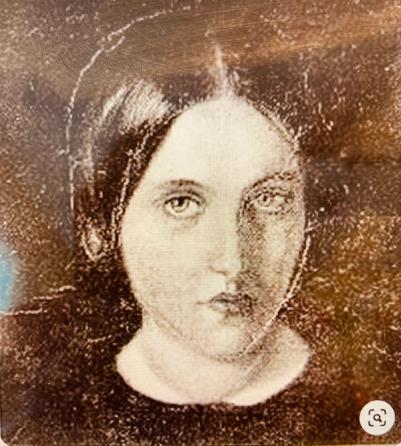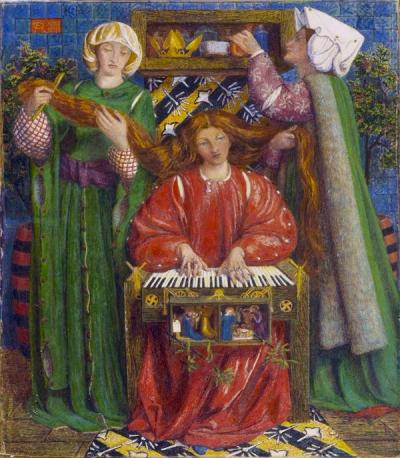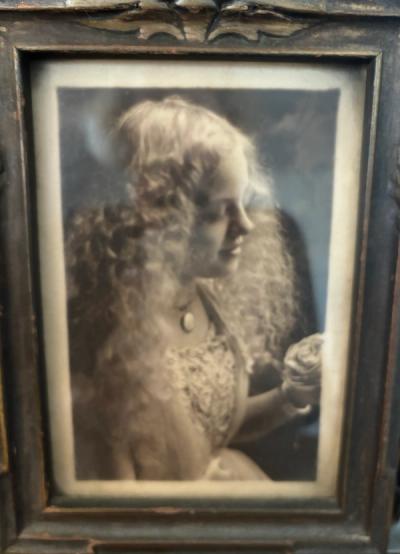Why Christina Rossetti?

My new historical mystery, The Lost Dresses of Italy, is about a grieving textile historian, Marianne Baxter, who travels to post-WWII Verona, Italy, to assist with an exhibit of long-lost Victorian dresses which once belonged to Pre-Raphaelite poet, Christina Rossetti. However, as Marianne uncovers the garments’ secrets, she finds herself in the midst of a far-reaching conspiracy of lies and murder—and obsessed with finding out what happened to Christina Rossetti during her trip to northern Italy.
Why did I choose to write about this poet?
I’ve always been an admirer of Christina Rossetti’s work and found it intriguing that she wrote and published poetry that seemed very exotic for a Victorian woman, even though she was a very private woman in her personal life. As one of the female members of the famous Rossetti family, she was painted many times by her brilliant artistic brother, Dante Gabriel, but she was never given the same freedom to live a free, bohemian existence. However, when she took a trip to Italy in her mid-thirties, she experienced something that caused her, on her return to London, to break off with her English suitor, Charles Cayley and, later, compose a highly-sensual sonnet sequence, the Monna Innominata—the “hidden woman.” I decided to write my fictional version of what happened, as discovered by Marianne, in Verona, through clues Christina left in three of her long-lost dresses. Poetry and fashion seemed an irresistible combination for a historical mystery.
So what happened to Christina in Italy?
You’ll have to read the book when it comes out . . .
A Season to Reflect and Celebrate

This year I have much to celebrate: we are finally in our new home (after losing ours in Hurricane Ian ), new family members have moved near us, and my new book, The Lost Dresses of Italy, is finally going to be published in February, 2024. A lot of “new” after a long drought of “old” post-hurricane recovery challenges. Yet, as I opened my heart to enjoy the holiday season, I found it a bit difficult, considering all of the people still struggling locally and around the globe where there is little cheer, to say the least.
So how do we find the seasonal magic?
For me, it’s always in poetry and art that reflect the holiday. And when Yule-time approaches, the two seem to blend in my favorite Pre-Raphaelite works that are somehow both sacred and secular. Those nineteenth-century artists and poets revived medieval traditions of carols in their poetry, used the warm color-pallet of red, green and gold in their paintings, and even etched angels in their stained-glass textiles. The dreamy beauty of how they interpreted the season evokes reflections on the year drawing to a close, along with the optimism of what the next year will bring.
It’s no coincidence that the “carol” conveys praise and joy but, also, a tinge of sadness. The Pre-Raphaelite poet, Christina Rossetti, creates a wintery melancholy behind the lyrics of her poem, “A Christmas Carol” with images of frost and snow:
In the bleak mid-winter
Frosty wind made moan,
Earth stood hard as iron,
Water like a stone;
Snow had fallen, snow on snow . . .
But her poem then moves into hope as Christina imagines the Nativity scene when “Heaven and earth shall flee away/ When He comes to reign,” and the bleakness of mid-winter fades in the face of Christ’s birth. Her carol takes place during the darkest time of year, but her religious beliefs guide her poetic expressions into the magic of the season through faith and hope. Her verse breathes with sacred inspiration.
In contrast, her brother, Dante Gabriel Rossetti’s painting, “A Christmas Carol” illuminates the indoor beauty of the season with medieval images, showing a queen (his long-time love, Lizzie Siddal) with flowing red hair and a dreamy expression, dressed in a scarlet gown as she plays the clavichord. All lush secular images in jewel-tones—a far cry from the bleak mid-winter of his sister. Yet he, too, adds a spiritual element by including Nativity scenes in the style of an illuminated manuscript on the front of the clavichord. The joy of the carol flows out of the painting almost like the music of the queen.
However one views the holiday season, it is always a time to reflect on beginnings and endings, darkness and light, joy and loss. And maybe that’s where the magic lies: we step out of our lives for a short while to read poetry or look at a painting—and think about what lies ahead.
I hope it will be a wonderful 2024 for everyone!
What is the Impetus Behind The Lost Dresses of Italy?

The impetus for my historical mystery had several seemingly unconnected threads (pun intended), including my life-long love of Christina Rossetti’s poetry, the Phantom Thread film about couture fashion, and an event from my past involving hidden items in a trunk. Like every writer, I file away things in the back of mind until one day, they coalesce into a story idea.
First, I’d like to speak to Rossetti—a Victorian poet of some renown during her time but somewhat forgotten today. Her poetry is simply transcendent, especially the lyrics and sonnets. She was part of the famous Rossetti family of artists, poets, and revolutionaries; but, she was also a very private woman. Her letters are somewhat prosaic, never revealing anything too personal, so I always had questions about her life, especially the three-week journey to northern Italy with her brother, William, and their mother. Afterwards, Rossetti wrote only one letter and one poem that referenced it; however, when she returned to London, she broke off with her suitor and, later, wrote a highly-sensual sonnet sequence, the Monna Innominata—the “hidden woman.”
What happened on that trip? Was she the hidden woman? I wanted to fill in the blanks because it seemed to me that it might have had a romantic element. As I began to sketch out the plot in 2021, I realized that I wanted to write the book as a dual narrative with a post-WWII costume curator who’s been asked to create an exhibit of Rossetti’s three dresses which were left hidden for a century in a trunk in Verona; the dresses hold the clues to what happened. That part of my novel was inspired by a scene in Phantom Thread, depicting seamstresses hiding little objects in the seams and hems of the couture gowns they create. I made Rossetti’s dresses central to solving the mystery. Also, the idea of the trunk holding secret objects harkens back to an episode when I was eighteen and my mother and I went through my recently deceased great-aunt’s cedar chest and found a marriage license, wedding sheets, and antique clothing. Apparently, she’d had a husband whom no one knew about for over twenty years—as we later confirmed. I never forgot that day when we opened the lavender-scented trunk and found those intimate, concealed items neatly packed away.
It was at that point in my life, I realized that everyone has secrets, and a writer should always dig for what people hide; that’s where stories grow interesting—like in the case of Christina Rossetti.
Copyright 2025 MartyAmbrose.com. All rights reserved